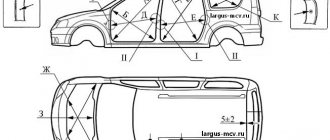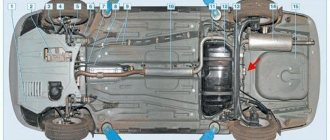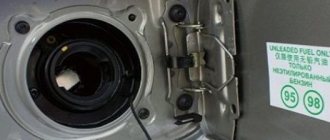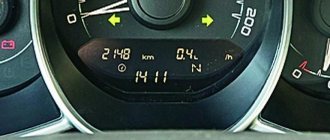Fuel tank volume Lada Vesta
When purchasing a car, most future owners are interested in the capacity of the fuel tank.
The vehicle's range is the distance the car can travel when the gasoline indicator begins to signal the last drops of fuel inside. The volume of the Lada Vesta fuel tank directly affects the distance covered by the car on its last breath. The most common numbers in the capacity parameter: 40, 50, 60, 70 liters. These figures clearly indicate the size of the vehicle. Accordingly, there are subcompact models, mid-size and full-size cars.
Lada Vesta fuel tank capacity
Electric GMC Hummer EV 2021: photos, prices, power reserve and release date in Russia
When buying a new car, most drivers wonder about the capacity of the fuel tank. This is far from the most important parameter, but it is a good indication of how many kilometers the car can travel from refueling to refueling. In other words, the capacity of the fuel tank directly indicates the vehicle's range. This parameter is important primarily for those who often travel long distances and do not know when the next gas station will come across their route.
The volume of the Lada Vesta fuel tank is the number of liters of fuel that the tank can hold before it is fully refueled. This indicator also indicates the size of the vehicle. If the car's tank does not exceed 30 liters, then a small-volume engine is most likely installed under the hood. If the volume of the fuel tank ranges from 40 to 60 liters, then this is a mid-size car. Well, if you can fill the tank with more than 70 liters, then you have a full-size car, such as a pickup truck or SUV.
Capacity according to technical data sheet
Fuel tank volume The documentation states: the tank volume of the Lada Vesta is 55 liters.
This applies to all models and trim levels of the new product from AvtoVAZ. Professionals and amateurs consider it a fairly high capacity indicator, because the main competitors Hyundai Solaris and Kia Rio have this figure significantly less - 43 liters. It is worth noting that the stated parameters do not always coincide with reality. There are examples when much more fuel is poured into the tank than the nameplate data suggests. The average increase in fuel volume in such cases is from 2 to 5 liters.
Lada Vesta is available with 1.6 and 1.8 liter internal combustion engines and has a robotic and manual transmission. Fuel consumption - very useful information - varies from 7 to 7.5 liters/100 km in the combined driving cycle.
Capacity in accordance with the technical data sheet.
The tank volume of the Lada Vesta, as indicated in the documentation, is 55 liters. This applies to all trim levels and models of new products from AvtoVAZ. Professionals believe that this is a high level of capacity, since the main competitors Kia Rio and Hyundai Solaris have a volume of only 43 liters.
It is worth noting that in practice, these parameters do not always correspond to reality. There are examples when more fuel is poured into the fuel tank than is written in the technical data sheet. In such cases, the average increase in volume is from two to five liters
Lada Vesta is manufactured with 1.6 and 1.8 liter engines and has bellows
nic and robotic transmission. Fuel consumption is an important indicator, which can vary from 7 to 7.5 liters per 100 kilometers during a mixed driving cycle.
The fuel tank of the Lada Vesta is made of plastic, which is now relevant for the automotive industry. It is equipped with thermal protection against a silenced resonator.
How much does the tank hold, according to the owners?
Gas tank of Lada Vesta It is worth knowing some features of the fuel tank in operation:
- Multiple surveys confirm that the volume depends on the car model.
- Owners say that in the very first refueling cycle, the tank can hold up to 57 liters of gasoline.
- The minimum fuel level indicator begins to warn the driver when the meter shows about 8 liters.
- If the amount of gasoline reaches the maximum level, the computer sensors will show that there will be enough fuel for 700 kilometers.
According to some experts, gas devices can increase the maximum travel distance by more than 300 km.
It must be remembered that the Lada Vesta car can consume both 92 and 95 gasoline. The latter accelerates the vehicle cleaner and faster. Fuel with a 92 octane rating is somewhat cheaper. Consumers fill up with such fuel to save significantly. However, these savings do not always have a good effect on the components of the power unit.
Lada Vesta gas tank volume
When purchasing a car, most future owners are interested in the capacity of the fuel tank. The vehicle's range is the distance the car can travel when the gasoline indicator begins to signal the last drops of fuel inside.
The volume of the Lada Vesta fuel tank directly affects the distance covered by the car on its last breath. The most common numbers in the capacity parameter: 40, 50, 60, 70 liters. These figures clearly indicate the size of the vehicle. Accordingly, there are subcompact models, mid-size and full-size cars.
Capacity according to technical data sheet
Fuel tank volume The documentation states: the tank volume of the Lada Vesta is 55 liters.
This applies to all models and trim levels of the new product from AvtoVAZ. Professionals and amateurs consider it a fairly high capacity indicator, because the main competitors Hyundai Solaris and Kia Rio have this figure significantly less - 43 liters. It is worth noting that the stated parameters do not always coincide with reality. There are examples when much more fuel is poured into the tank than the nameplate data suggests. The average increase in fuel volume in such cases is from 2 to 5 liters.
Lada Vesta is available with 1.6 and 1.8 liter internal combustion engines and has a robotic and manual transmission. Fuel consumption - very useful information - varies from 7 to 7.5 liters/100 km in the combined driving cycle.
How much does the tank hold, according to the owners?
Gas tank of Lada Vesta It is worth knowing some features of the fuel tank in operation:
- Multiple surveys confirm that the volume depends on the car model.
- Owners say that in the very first refueling cycle, the tank can hold up to 57 liters of gasoline.
- The minimum fuel level indicator begins to warn the driver when the meter shows about 8 liters.
- If the amount of gasoline reaches the maximum level, the computer sensors will show that there will be enough fuel for 700 kilometers.
According to some experts, gas devices can increase the maximum travel distance by more than 300 km.
It must be remembered that the Lada Vesta car can consume both 92 and 95 gasoline. The latter accelerates the vehicle cleaner and faster. Fuel with a 92 octane rating is somewhat cheaper. Consumers fill up with such fuel to save significantly. However, these savings do not always have a good effect on the components of the power unit.
Results
The fuel tank of the Lada Vesta has a very large capacity, surpassing some foreign representatives in this indicator. This provides enormous benefits for car owners who do not have to think about frequent visits to gas stations with such a fuel volume.
The indicators of the critical amount of fuel on the Lada Vesta on-board computer are triggered at around 8 liters, which gives a lot of time to easily get to the gas station. The tank capacity of the new product from AvtoVAZ should not disappoint buyers of this car, which claims further superiority within the Russian sales market.
I also remembered looking at it at night. According to the docks, the Vesta has a gas tank of 55 liters, leaving the salon I filled the tank full until two clicks, 57 liters came in, I think, if you have the desire and diligence, you can stuff up to 60 (for comparison, I poured 48 max into the Datsun, 56 into the Hyundai i30).
In general, a practical thing for long-distance travel, where the distance between gas stations is large. Lew 95 ecto from Lukoil, in Datsun lil 92.
I also took a photo of how the panel glows at night, it’s cute, informative, and doesn’t irritate the eyes. The on-board computer is simple, controlled by buttons on the right steering column joystick. Consumption in the cabin showed 30 liters per hundred, now it has dropped to 14 liters.
Another observation from requests is that on the ring at a speed of 110 km/h on the robot the revolutions are slightly less than 3 kpm. I didn’t turn it anymore (according to the service book, they recommend up to 110 km per hour and no more than 3.5 krpm)
When buying a new car, most drivers wonder about the capacity of the fuel tank. This is far from the most important parameter, but it is a good indication of how many kilometers the car can travel from refueling to refueling. In other words, the capacity of the fuel tank directly indicates the vehicle's range. This parameter is important primarily for those who often travel long distances and do not know when the next gas station will come across their route.
The volume of the Lada Vesta fuel tank is the number of liters of fuel that the tank can hold before it is fully refueled. This indicator also indicates the size of the vehicle. If the car's tank does not exceed 30 liters, then a small-volume engine is most likely installed under the hood. If the volume of the fuel tank ranges from 40 to 60 liters, then this is a mid-size car. Well, if you can fill the tank with more than 70 liters, then you have a full-size car, such as a pickup truck or SUV.
Lada Vesta fuel tank capacity in numbers
If we talk about our car, the volume of the Lada Vesta fuel tank is 55 liters. This figure does not depend on the configuration, engine, or year of manufacture. On all Vestas without exception, one type of tank is installed - 55 liters. If compared with its main competitors Solaris or Rio, then this figure will look more modest - only 43 liters.
But even with Vesta, not everything is so simple. Most often, you can fill the tank with much more fuel than indicated in the passport. The fact is that fuel can completely fill the tank and be in the neck all the way to the cap. The volume of the neck is not taken into account, so these are the numbers. Often they can exceed 3 liters or more. In other words, 55-60 liters of fuel can be poured into the Lada Vesta fuel tank, provided that the tank is completely empty.
How many kilometers will the full volume of the Lada Vesta fuel tank last?
First, let's figure out when the low fuel light comes on on the Lada Vesta dashboard. So here it is. This light starts to light when there are about 8 liters of fuel left in the tank.
When you fill up a full tank, the on-board computer will signal to you that this amount of fuel will be enough for 700 km. This figure is very close to the real one, as numerous reviews from owners fully confirm this. Of course, there are also disproving reviews on this matter. But the fact is that not everyone takes into account fuel consumption for warming up and downtime at traffic lights.
Results
The fuel tank of the Lada Vesta has a very large capacity, surpassing some foreign representatives in this indicator. This provides enormous benefits for car owners who do not have to think about frequent visits to gas stations with such a fuel volume.
The indicators of the critical amount of fuel on the Lada Vesta on-board computer are triggered at around 8 liters, which gives a lot of time to easily get to the gas station. The tank capacity of the new product from AvtoVAZ should not disappoint buyers of this car, which claims further superiority within the Russian sales market.
Fuel tank Lada Vesta
You need to know certain features of the device in operation:
- according to survey results, volume is directly related to the car model;
- car owners say that during the first refueling cycle, up to 57 liters of fuel can be placed in the tank;
- the indicator that controls the gasoline level begins to light when about 8 liters remain;
- if the amount of fuel has reached the maximum level, the computer sensor will show that there is enough gasoline to cover 700 kilometers.
It must be remembered that Lada Vesta can be filled with 92 and 95 gasoline. The latter accelerates the vehicle more often and faster. Fuel with 92 number is cheaper. Consumers use such fuel to save money, but such savings are not always reflected well on engine components.
What is the volume of the fuel tank on the Lada Vesta
The Lada Vesta car has a tank volume, which directly affects the distance traveled by the vehicle on its last breath.
The most common capacity is 40, 50, 60, 70 liters. These figures depend on the size of the vehicle. There are subcompact, mid-size and full-size cars.
Capacity in accordance with the technical data sheet.
The tank volume of the Lada Vesta, as indicated in the documentation, is 55 liters. This applies to all trim levels and models of new products from AvtoVAZ. Professionals believe that this is a high level of capacity, since the main competitors Kia Rio and Hyundai Solaris have a volume of only 43 liters.
It is worth noting that in practice, these parameters do not always correspond to reality. There are examples when more fuel is poured into the fuel tank than is written in the technical data sheet. In such cases, the average increase in volume is from two to five liters
Lada Vesta is manufactured with 1.6 and 1.8 liter engines and has bellows
nic and robotic transmission. Fuel consumption is an important indicator, which can vary from 7 to 7.5 liters per 100 kilometers during a mixed driving cycle.
The fuel tank of the Lada Vesta is made of plastic, which is now relevant for the automotive industry. It is equipped with thermal protection against a silenced resonator.
Fuel tank Lada Vesta
You need to know certain features of the device in operation:
- according to survey results, volume is directly related to the car model;
- car owners say that during the first refueling cycle, up to 57 liters of fuel can be placed in the tank;
- the indicator that controls the gasoline level begins to light when about 8 liters remain;
- if the amount of fuel has reached the maximum level, the computer sensor will show that there is enough gasoline to cover 700 kilometers.
It must be remembered that Lada Vesta can be filled with 92 and 95 gasoline. The latter accelerates the vehicle more often and faster. Fuel with 92 number is cheaper. Consumers use such fuel to save money, but such savings are not always reflected well on engine components.
Results
The fuel tank of the Lada Vesta has good capacity, surpassing some foreign cars in volume. This provides great benefits for car owners to not have to worry about...
frequent visits to gas stations.
Indicators that are triggered when a critical amount of fuel on the Lada Vesta computer begin to signal at around 8 liters, which makes it possible to easily get to the gas station.
The fuel tank capacity of the new product from AvtoVAZ should completely suit the buyers of this car, which lays claim to future superiority within the domestic sales market.
Results
The fuel tank of the Lada Vesta has good capacity, surpassing some foreign cars in volume. This provides great benefits for car owners to not have to worry about...
frequent visits to gas stations.
Indicators that are triggered when a critical amount of fuel on the Lada Vesta computer begin to signal at around 8 liters, which makes it possible to easily get to the gas station.
The fuel tank capacity of the new product from AvtoVAZ should completely suit the buyers of this car, which lays claim to future superiority within the domestic sales market.
Capacity
The manual from AvtoVAZ tells us that the tank volume of the Lada Vesta is 55 liters. This figure is superior to competitors. For example, in the Hyundai Solaris the gas tank contains only 43 liters. It is made of plastic, unlike other cars from this manufacturer.
In practice, it is known that in fact 10% more fuel can enter Vesta’s tank.
The average increase in fuel is in the range of 2-5 liters. Vesta is produced with 1.6 and 1.8 liter engines and is equipped with mechanical and robotic gearboxes. Gasoline consumption in the combined cycle is 7.5 liters per 100 km.
Power reserve
According to the results of practical tests of car owners, the capacity of the gas tank differs between different cars of the same brand. Some drivers claim that the gas tank holds up to 57 liters, others - only 54 liters. After filling it up to the neck, the computer says that the estimated range is 695 km.
Experts say that after installing gas equipment on the Lada Vesta, you can drive another 300 km without additional refueling.
The fuel capacity of this brand of car exceeds that of many foreign cars. Therefore, the owner may not be afraid to drive long distances, and not worry that gasoline will soon run out.
The on-board computer does not always show the correct mileage information.
Practice shows
From actual operation, the following can be said about the capacity of the tank:
- The indicator depends on the make of the car.
- When initially refueling a new car, 57 liters can enter.
- An indicator on the instruments warns the driver when 8 liters of fuel remain.
- With a full tank, the computer can display a range of 695-700 km.
Lada Vesta can be filled with 92 or 95 gasoline, but the latter is more preferable.
92 gasoline is poured in to save money, but this negatively affects the engine's service life. If you can share your experience of operating this X-style car, then write to us in the comments.
How much fuel does a standard Lada Vesta tank hold?
In the Operation Manual in the “technical specifications” section it is written that the capacity of the Lada Vesta’s fuel tank is 55 liters . Is this too much? Yes, enough. If we take previous VAZ models, the maximum capacity is 50 liters. As for foreign car competitors, Vesta is also the leader here, ahead of Rio and Solaris by as much as 12 liters.
The range with a full tank according to the BC (on-board computer) is 693 km. But when installing HBO, the power reserve can be increased up to 1000 km. Let us remind you that there have been changes at the legislative level; now the presence of LPG must be confirmed in the vehicle’s STS, but that’s not what we’re talking about now..
How many kilometers will the full volume of the Lada Vesta fuel tank last?
First, let's figure out when the low fuel light comes on on the Lada Vesta dashboard. So here it is. This light starts to light when there are about 8 liters of fuel left in the tank.
When you fill up a full tank, the on-board computer will signal to you that this amount of fuel will be enough for 700 km. This figure is very close to the real one, as numerous reviews from owners fully confirm this. Of course, there are also disproving reviews on this matter. But the fact is that not everyone takes into account fuel consumption for warming up and downtime at traffic lights.
How much fuel can you actually put in the tank?
Despite the fact that the volume of the Vesta tank is 55 liters, you can also use the volume of the filler pipes in the tank, which will increase the capacity. If you fill it up to the very neck with pistol shots and constant topping up, then the tank in Vesta will hold 58 liters . I don’t know whether 60 liters will fit, I haven’t personally tried it, but if it does, then doubts will arise about the meter at the gas station)).
By the way, it is possible that during the production of Vesta, the volume of the fuel tank will be changed in order to please the car owner as much as possible. So, using an example, we can answer the increase in the tank on Kalina from 43 to 50 liters.
When does the fuel light come on?
If the gasoline level drops to the red zone, then there are approximately 7-8 liters of gasoline left in the tank. Therefore, it is better not to wait too long with refueling.
Lada Vesta tank volume - how long can you drive?
In Lada Vesta, the tank volume according to the vehicle’s technical passport reaches 55 liters. And this is an excellent result for the Lada Vesta and its fuel tank volume. If we take previous modifications of the vehicle, then the largest capacity reaches 50 liters. Among foreign cars, the Vesta sedan is similarly superior, beating Rio and Solaris by as much as 12 hp. Read the article and find out the competitors’ capacities and the secrets of the power reserve!
The power reserve with a completely filled tank according to the BC (PC) is 693 kilometers. However, when installing LPG, the mileage reserve can be increased even by 1000 kilometers, which for the owner can be a key factor when installing gas equipment. Let us remember that changes have occurred in the legislative field; now the presence of gas equipment must be recorded - STS of the vehicle.
If you need a gas tank for Vesta, then its catalog number (article) is 8450008544.
How much fuel can you actually put in Vesta's tank?
The Vesta tank size is 55 liters; it is possible to use a filler pipe for the tank, which will increase the introduced fuel size. If you pour gasoline all the way, shooting the pistol and regularly topping up, then the car’s tank will hold 58 liters. Whether a 60-liter unit will fit has not yet been fully studied, but if it does, there will be fluctuations in the results of the meter at the station’s filling machine.
During the release of the Lada Vesta, the tank volume will change for other cars of the VAZ family, in order to fully satisfy the car owner. An increase in the volume of Kalina's tank is expected soon5 from 43 to 50 liters.
How far can you drive when the fuel light comes on?
If the indicator - the capacity of the fuel tank of the Lada Vesta has dropped to the scarlet mark, then there are approximately 7-8 liters left in the tank. It’s better not to take too long with fuel and refueling.
The material used in the manufacture of the fuel tank is plastic, and this is important for the current driver. It contains a thermal protection function against the resonator mechanism and the muffler.
They say: Despite its significant capacity, pouring fuel from a car is easier than usual, similar to most all types of Zhiguli (Lada models). is this true, look in the video
The manufacturer did not think about the system for closing the tank hatch, and about the mesh in the fill neck. A hatch with a lock is only available in Lada Vesta Cross models. In fact, Vesta owners install a Logan lid with a lock. The price of such a Chinese copy is 350 rubles.
The capacity of the tank, together with the economical consumption of gasoline or gas (the real fuel consumption of the Lada Vesta), makes this model a “monster” of the road.
Tank of Lada Vesta's closest competitors:
- Kia Rio - 50 l;
- Hyundai Accent - 45 l;
- Polo - 55 l;
- Skoda Actavia - 50 or 55 l;
- Ford Focus - 55 l.
The more common volumes of fuel tanks in cars are: 40, 50, 60, and also 70 liters. According to the capacity of the gas tank, it should be noted what degree of engine volume the car has. If the tank is designed to hold 30 liters, then we are talking about small cars. 50 or 60 l. - this is average. And 70 speaks of a car with a large volume.
A large tank size would not be required if fuel consumption was not such an important parameter. Understanding the average fuel consumption, it is easy to determine how many kilometers a car will travel with a full tank of fuel. The BCs of current cars can quickly show these indicators.
Cruising range on gasoline - if the tank is full
The size of a gasoline tank in the same modification can vary. Vesta owners report that the tank usually holds from 54 to 57 liters. gasoline. Once the car's fuel tank is filled to the brim, the car's PC will demonstrate that there is enough fuel for 695 km (due to negligible costs). Experts report that by installing special gas equipment, the vehicle’s range without refueling gasoline can be increased to another 300 km.
Experts agreed with the conclusion that the fuel reserve of a full tank of the Lada 2190 is considered significant. This means that the car owner is able to confidently cope with long distances without worrying about fuel. In fact, the car PC does not regularly show the highest possible mileage on a single fill-up.
Gas range of Vesta CIS
If we compare a “gas” car in daily use, then using a methane car is more economical. The price of compressed natural gas is 3 times more economical than fuel. By all parameters, it turns out that the more the owner drives, the cheaper it is to use the car. The unconditional superiority of the Lada Vesta CIS is its overall range.
With smooth trips on gas, you can travel 350 kilometers, plus 750 km on fuel, and that’s 1,100 km. This sedan will be able to travel a significantly longer distance than its classmates in other Lada models.
Conclusion
The fuel limit indicator in the car PC fixes the mark at 8 liters, which provides a significant reserve in order to freely get to the gas station. The tank capacity of the Lada 2190 will not disappoint consumers of the Vesta car. Drawing conclusions, we note that the car is suitable for driving around the city and over long distances.
Video of refueling an empty Vesta tank
In the video, the author fills Vesta with 98 gasoline. but is it worth it? We'll talk about this in the next article: What fuel to use? 92 or 95?
The fuel tank material is plastic, which is quite relevant for the modern automobile industry. Has thermal protection from the resonator with a muffler. Despite the large capacity, draining gasoline from Vesta is as easy as shelling pears, as in all Zhiguli cars) The manufacturer did not think through closing the gas tank flap or the mesh in the filler neck. The cap is in the filler neck, what should I do?
A spacious tank, coupled with acceptable fuel consumption (Real fuel consumption of the Lada Vesta), makes the Lada Vesta a highway killer. For complete comfort, all that remains is to add lumbar support and more comfortable seats, so as not to get tired at all while driving. Home page
Gas tank Lada Vesta
The gas tank of a vehicle is an important component; unfortunately, at the moment they have not yet released a model that does not require fuel in any form.
The volume of the fuel tank is also important, because the distance that the car can travel without refueling depends on the maximum volume. For passenger models, manufacturers try to install a tank of a volume that is enough for plus or minus 500 kilometers of autonomous driving. On cars of the Lada Vesta family, the location of the gas tank is almost the same. It is installed in front of the axle of the rear wheels, as a result of which it is located directly under the sofa of the rear row of seats, by removing which you can gain access to the fuel pump.
Refueling is carried out through the gas tank flap, which is located on the right on all models of the family; by the way, there is an indicator on the dashboard indicating which side the gas tank neck is located on. The function is very useful for those who have just bought a car, drove to a gas station and remembered that they do not know which way to approach the gas station. Finding the indicator is quite simple, it is located in the right well (see photo below), which also displays the current volume of the fuel tank, as well as the engine temperature.
Technical characteristics of Lada Vesta
The long-awaited new product in the Russian segment of budget cars - the Lada Vesta sedan - in its overall dimensions is on the border of B and C classes. The length of the car is 4410 mm, width – 1764 mm, height – 1497 mm, wheelbase – 2635 mm. Underbody clearance of 178 mm allows you to confidently move on roads with poor surfaces, be it asphalt riddled with holes or a country dirt road. In addition to high ground clearance, good geometric cross-country ability is ensured by fairly short overhangs: front – 860 mm, rear – 915 mm.
The Lada Vesta engine line includes several gasoline power plants. From the start of sales, the car is offered only with a 1.6-liter engine producing 106 hp. This four-cylinder unit with serial number 21129 is a Russian development and is installed on other AvtoVAZ models, for example, on the same Lada Granta liftback. Later, the sedan’s engine range will be replenished with H4M (1.6 liters, 110 hp) and 21179 (1.8 liters, 122 hp) engines. The first engine is provided by the Renault-Nissan alliance, the second is domestically developed.
Technical characteristics of Lada Vesta engines:
| Parameter | 1.6 106 hp | 1.6 110 hp | 1.8 122 hp |
| Engine code | 21129 | H4M | 21179 |
| engine's type | petrol without turbocharging | ||
| Supply system | distributed injection | ||
| Number of cylinders | 4 | ||
| Cylinder arrangement | in-line | ||
| Number of valves | 16 | ||
| Cylinder diameter, mm | 82.0 | 76.0 | 82.0 |
| Piston stroke, mm | 75.6 | 88.0 | 84.0 |
| Compression ratio | 10.45:1 | 10.7:1 | 10.3:1 |
| Working volume, cubic meters cm. | 1596 | 1598 | 1774 |
| Power, hp (at rpm) | 106 (5800) | 110 (5500) | 122 (5900) |
| Torque, N*m (at rpm) | 148 (4200) | 150 (4000) | 170 (3700) |
| Weight, kg | 105.4 | 92.5 | 109.7 |
It will be useful: Installing an alarm system on a Lada Priora with your own hands: step-by-step instructions for installing the system, features of central locks, connection points and location
Gearboxes are represented by a 5-speed “mechanics” Renault (index JH3) and a 5-speed VAZ “robot”. The manual transmission is based on a manual transmission 2180, which was supplemented with a Valeo clutch and a gear shift mechanism from ZF. The transmission was developed back in 2014, and since then it has been installed on many Tolyatti models.
Technical characteristics of Lada Vesta gearboxes:
| Parameter | 5-speed manual transmission | 5-speed manual transmission | |
| Model | JH3 510 | 21827 | |
| Gear ratio | 1st gear | 3.727 | 3.636 |
| 2nd gear | 2.048 | 1.950 | |
| 3rd gear | 1.393 | 1.357 | |
| 4th gear | 1.029 | 0.941 | |
| 5th gear | 0.795 | 0.784 | |
| Reverse | 3.545 | 3.500 | |
| Weight, kg | 33.0 | 33.1 | |
The suspension of the Lada Vesta is arranged according to the classic design: MacPherson struts are installed in front, and a torsion beam is installed in the rear. The rack-and-pinion steering mechanism is equipped with an electric booster.
The luggage compartment of the car boasts a decent volume of 480 liters. It is also possible to tow an unbraked trailer weighing up to 450 kg. If the trailer has brake mechanisms, its weight should not exceed 900 kg.
Fuel consumption of a Lada Vesta with a 106-horsepower engine and manual transmission does not exceed 6.9 liters per 100 km. The modification with a robotic gearbox is more economical - on average it consumes 6.6 liters. In terms of dynamic characteristics, the manual version has an advantage, accelerating to “hundreds” in 11.2 seconds. A car with a “robot” is almost 3 seconds slower.
What is the real volume of the fuel tank on cars of the Lada Vesta family
On all models of the family, the gas tank has a fixed volume of 55 liters, the figure is indicated by the manufacturer and is official. Most experiments with refueling and calculating the occupied capacity of gasoline in the fuel tank confirm the data presented. However, several owners managed to fill their Lada Vesta with several liters more, most likely due to deception on the part of the gas stations whose services they used.
The dual-fuel Lada Vesta CNG has two fuel tanks installed at once, a regular gasoline tank with a volume of 55 liters and a gas cylinder with a volume of 90 liters, for refueling the corresponding type of fuel.
Depending on your personal driving style, a gas tank with a capacity of 55 liters will be enough for approximately 600 kilometers of road without refueling. However, it is worth considering that long driving with a small amount of gasoline in the tank is highly not recommended. The fact is that the gas pump installed in the gas tank is cooled by fuel, if the level is low, cooling occurs more slowly and the gas pump motor may fail prematurely.
Also, don't forget to use the on-board computer when planning your next fuel stop. The on-board computer system has functionality that calculates how many kilometers of road the current amount of fuel will last; the calculation is made taking into account your driving style and the amount of fuel spent over the previous 100 kilometers.
Main technical characteristics of Lada Vesta
The LADA Izhevsk enterprise currently produces only the LADA Vesta sedan, but in the future AVTOVAZ intends to launch the production of station wagons, crossovers and several sports modifications based on this model.
The car was created on its own “B” platform, which they plan to use in the future for the production of both domestic cars and models under the Renault-Nissan Alliance brands. Many components on the new product are of foreign origin and borrowed from other models, but gradually production is moving more and more to domestic components, which allows reducing production costs.
Table of Lada Vesta characteristics (TTX)
| 1.6 l 16 cl. (106 hp), 5AMT | 1.6 l 16 cl. (106 hp), 5MT | |
| Body | ||
| Wheel formula / drive wheels | 4 x 2 / front | 4 x 2 / front |
| Engine location | anterior transverse | anterior transverse |
| Body type / number of doors | sedan / 4 | sedan / 4 |
| Number of seats | 5 | 5 |
| Length / width / height, mm | 4410 / 1764 / 1497 | 4410 / 1764 / 1497 |
| Base, mm | 2635 | 2635 |
| Front/rear wheel track, mm | 1510 / 1510 | 1510 / 1510 |
| Ground clearance, mm | 178 | 178 |
| Luggage compartment volume, l | 480 | 480 |
| Engine | ||
| Engine code | 21129 | 21129 |
| engine's type | petrol | petrol |
| Supply system | electronically controlled fuel injection | electronically controlled fuel injection |
| Number, arrangement of cylinders | 4, in-line | 4, in-line |
| Working volume, cubic meters cm | 1596 | 1596 |
| Maximum power, kW (hp) / rev. min. | 78 (106) / 5800 | 78 (106) / 5800 |
| Maximum torque, Nm/rev. | 148 / 4200 | 48 / 4200 |
| Fuel | gasoline, min 92 | gasoline, min 92 |
| Dynamic characteristics | ||
| Maximum speed, km/h | 178 | 175 |
| Acceleration time 0-100 km/h, s | 14,1 | 11,2 |
| Fuel consumption | ||
| Urban cycle, l/100 km | 9,0 | 9,3 |
| Extra-urban cycle, l/100 km | 5,3 | 5,5 |
| Combined cycle, l/100 km | 6,6 | 6,9 |
| Weight | ||
| Curb weight, kg | 1230…1280 | 1230…1280 |
| Technically permissible maximum weight, kg | 1670 | 1670 |
| Maximum trailer weight without brake system / with brake system, kg | 450 / 900 | 450 / 900 |
| Fuel tank volume, l | 55 | 55 |
| Transmission | ||
| Transmission type | 5AMT | 5MT |
| Final drive ratio | 3,9 | 3,9 |
| Suspension | ||
| Front | independent, MacPherson type, spring, with anti-roll bar | independent, MacPherson type, spring, with anti-roll bar |
| Rear | semi-independent with linked levers, spring, with gas-filled telescopic shock absorbers | semi-independent with linked levers, spring, with gas-filled telescopic shock absorbers |
| Steering | ||
| Steering gear | rack and pinion | rack and pinion |
| Tires | ||
| Dimension | 185/65 R15 (88, N/T); 195/55 R16 (91, T) | 185/65 R15 (88, N/T); 195/55 R16 (91, T) |
The sedan is designed for 5 passengers, and its technically permissible curb weight is 1,670 kg. Curb weight varies from 1230 to 1280 kg, depending on the configuration. The maximum weight of a towed trailer without a brake system is 450 kg, with a brake system 900 kg.
It will be useful: Error codes for Lada Priora 8 and 16 valves with and without air conditioning: decoding
The fuel tank volume is 55 liters, dual-fuel modifications have additional 2 gas cylinders, which are designed for pressure up to 250 atmospheres. According to the manufacturer itself, fully filled cylinders allow Vesta to travel 1,000 kilometers without refueling.
How to open the gas tank flap on Lada Vesta cars
On the first Lada Vesta, the gas tank flap did not have a locking mechanism, as a result of which anyone could open it.
Car owners and car reviewers did not like this design at all. AvtoVAZ quickly responded to this defect and soon cars appeared with a key for the neck cover, and a little later the hatch itself acquired a locking mechanism. In order to open the gas tank flap, just press your finger on the left side of the hatch, while the central lock of the Lada Vesta must be unlocked, since it also blocks access to the gas tank.











